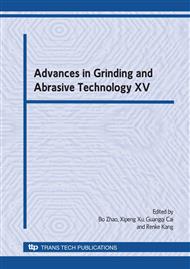p.391
p.396
p.401
p.406
p.411
p.416
p.421
p.426
p.432
Theoretical Research and Verification on the Porosity of Semi-Fixed Abrasive Tool
Abstract:
Semi-fixed abrasive tool is a new developed grinding wheel which can adjust abrasive grain near the workpiece-abrasive interface according to the situation of the hard and large grits, damaged surface layer generated by the scratch or crack could be decreased when using semi-fixed wheel. Porosity, one of the most important parameters to evaluate trap effect, was studied based on the analysis of uniform scratch and it’s effect on the polishing time, contact models between circle abrasive grain, line boundary and circle boundary were deduced to investigate the relations between engagement depth and the ratio of normal force to normal elastic stiffness. Theoretical research results show that semi-fixed grinding wheel should be conditioned after it’s compaction for the boundary between abrasive grain and line boundary is unstable, the contact status is stable for internal abrasive grain, predicted porosity value agree well with that measured in the experiment, the shear strength of semi-fixed abrasive tool can meet the demand of lapping and polishing processes.
Info:
Periodical:
Pages:
411-415
Citation:
Online since:
September 2009
Authors:
Keywords:
Price:
Сopyright:
© 2009 Trans Tech Publications Ltd. All Rights Reserved
Share:
Citation:


